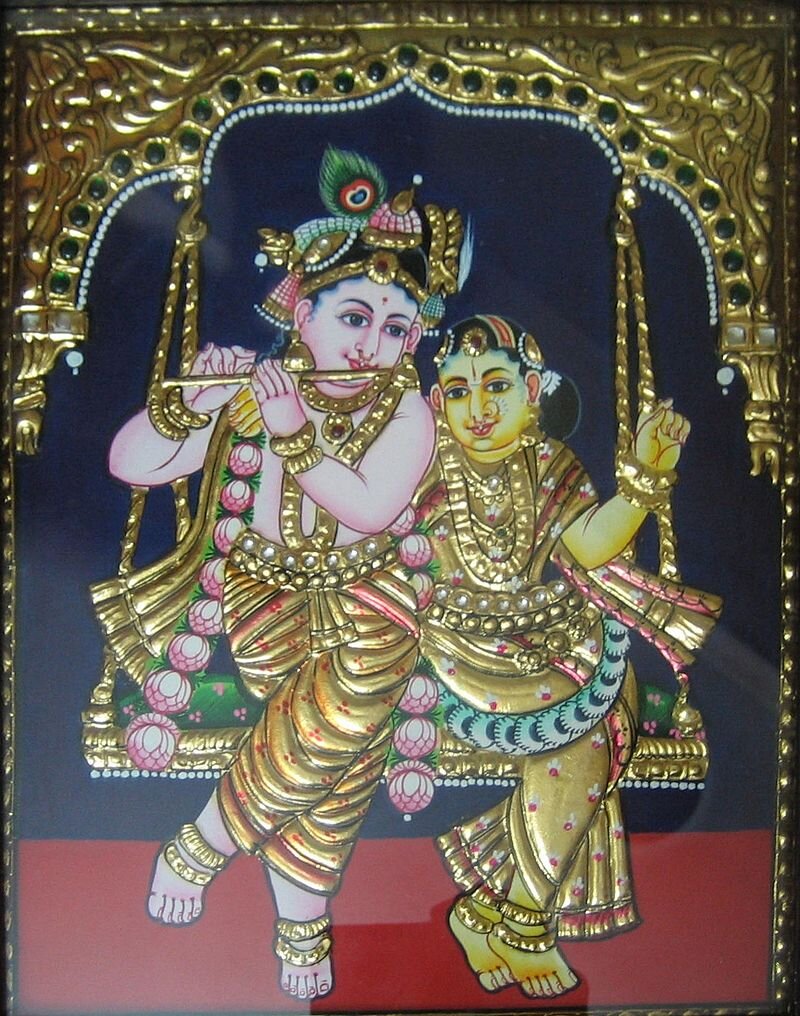Thanjavur painting is a classical South Indian painting style, which was inaugurated from the town of Thanjavur also known as Tanjore. The art form draws its immediate resources and inspiration from way back about 1600 AD, a period when the Nayakas of Thanjavur under the suzerainty of the Vijayanagara Rayas encouraged art.
A Thanjavur painting of Krishna and Rukmini
Classical dance and music as well as literature, both in Telugu and Tamil and painting of chiefly Hindu religious subjects in temples. It is distinguished by its famous gold coating. However, it can safely be surmised that Thanjavur painting, as we know it now, originated in the Maratha court of Thanjavur (1676–1855).
History
The fall of the Vijayanagar Empire and the sack of Hampi in the Battle of Talikota in 1565 CE resulted in the migration of painters who had been dependent on the patronage of the empire. Some of them migrated to Thanjavur and worked under the patronage of the Thanjavur Nayakas. Subsequently, the Maratha rulers who defeated the Thanjavur Nayakas began to nurture the Thanjavur atelier.
Sikh Gurus with Bhai Bala and Bhai Mardana – 20th century
The artists absorbed the local influences and the individual tastes of their Maratha patrons which helped evolve the unique Thanjavur style of painting. The Thanjavur artists in addition to decorating temples also began painting and decorating the major buildings, palaces, chatrams and residences of the Maratha kings and nobility.
Vijayanagara Rayas
Vijayanagar empire ensured that the older Hindu artistic traditions were protected and preserved. In 1521–22, Krishnadevaraya travelled to the Tamil country (Tamilagam) visiting holy places, made munificent donations to temples and other religious establishments. It can be surmised that some of this munificence was also channeled into art and artists.
Thanjavur Nayakas
The Vijayanagar Rayas administered their vast kingdom through Nayaka Governors who also administered the outlying provinces or states under the supervision of the Raya. It was during Achyutappa's reign that the Vijayanagara empire fell, leading to numerous litterateurs, philosophers, musicians and artists who migrated to several other neighbouring kingdoms like Mysore and Thanjavur. Thanjavur Nayaka ruler, was also a great patron of art and artists and helped establish the unique school of Thanjavur artists who later evolved the Thanjavur style of paintings under the Marathas.
Style and Techniques
Thanjavur paintings were made in various sizes depending upon the function, the subject and the choice of the patron. Large paintings of deities and the Maratha rulers, their courtiers and nobility, were painted and installed to serve as architectural accents in the Maratha palaces and buildings. Their dazzling palette consisted generally of vivid reds, deep greens, chalk white, turquoise blues and the lavish use of gold (foil) and inset glass beads. Sometimes precious stones were also used in the paintings. A Thanjavur Painting was generally made on a canvas pasted over a plank of wood (Jackfruit or teak) with Arabic gum.
A painted brass repousse of Tirupati Balaji 19th century
The canvas was then evenly coated with a paste of French chalk (gopi) or powdered limestone and a binding medium and dried. The artist then drew or traced using a stencil, a detailed outline of the main and subsidiary subjects on the canvas. A paste, made of limestone powder and a binding medium called sukkan or makku, was used for creating the Gesso work. Gold leaves and gems of varied hues were inlaid in selected areas like pillars, arches, thrones, dresses, etc. Finally, colours were applied on the sketch.
Processional scene with Amar Singh, ruler of Thanjavur (1787–98) and Sarabhoji (1798–1832)
For outlines dark brown or red was usually used. Red was favoured for the background, though blue and green were also used. Lord Vishnu, was coloured blue, and Lord Nataraja chalk white, and his consort Goddess Sivakami was green. The sky was blue, but black was also employed on occasions.
Nayaka period paintings in the Peruvudaiyar Koil





